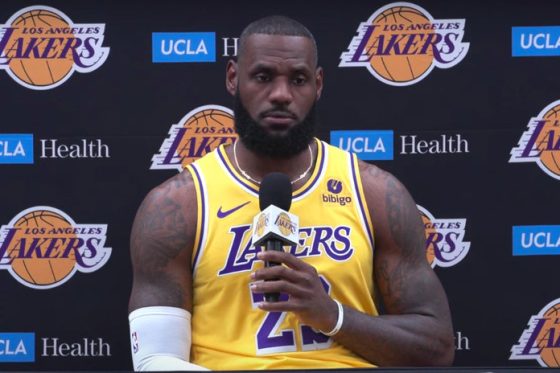For the second-straight year, the Big 12 has added four new teams to the conference. Pac-12 refugees Arizona, Arizona State, Colorado and Utah have all found asylum in the conference. The top two conference-play teams from last season, Oklahoma (15-3) and Texas (14-4, Big 12 Tournament champions) have departed for the SEC.
Four Big 12 teams found their names in the AP preseason top 25: Iowa State (No. 8), Baylor (No. 12), Kansas State (No. 13), and West Virginia (No. 16). The Big 12 coaches preseason poll picked Kansas State as early favorites to win the conference. The full rankings are:
- Kansas State
- Iowa State
- Baylor
- TCU
- West Virginia
- Utah
- Arizona
- Kansas
- Colorado
- Texas Tech
- Oklahoma State
- BYU
- Cincinnati
- UCF
- Arizona State
- Houston
It’s not often that a conferences loses its two most dominant teams in the same season. Without Texas and Oklahoma, the opportunity for both experienced and youthful teams to win a Big 12 title has never been greater. So, how do the teams stack up?
Iowa State
Audi Crooks, stomping into her sophomore season, may never be overlooked again. Crooks was only the No. 57-ranked women’s basketball recruit in the class of 2023 according to ESPN’s HoopGurlz. She ended her freshman year as one of the most promising young players in the country. Crooks set the Iowa State record for most field goals made in a season, and was the first freshman in school history to be named an AP All-American honorable mention. She was the third highest scoring freshman in the country, trailing USC’s JuJu Watkins and Notre Dame’s Hannah Hidalgo.
Don’t let the heliocentric nature of Crook’s usage fool you—this Iowa State team has depth. Last season they took No. 9 ranked Stanford to overtime in the second round of the NCAA Tournament, losing by only six despite Crooks shooting an abysmal 3-for-21. Addy Brown, also entering her second season, averaged 13 points, eight rebounds, and five assists as a freshman.
Iowa State will make the NCAA Tournament. That seems like a foregone conclusion. However, their ability to contend for a Big 12 championship, and a national championship, may be intrinsically tied to whether Crooks can take a sophomore playmaking leap and expand her horizons beyond scoring.
Kansas State
:no_upscale()/cdn.vox-cdn.com/uploads/chorus_asset/file/25703417/1925162566.jpg)
This season may be one last ride for Kansas State’s current roster, and expectations have never been higher. Kansas State has been voted conference favorites by the Big 12 coaches for the first time in program history.
6-foot-6 super-senior Ayoka Lee was named Big 12 Preseason Player of the Year after averaging 20 points and eight rebounds last season. She led the conference in field goal percentage, win shares and plus minus. She was second in blocks and third in rebounds. Lee is K-State’s lone graduate student, but their roster champions five other seniors. Serena Sundell joins Lee on the Preseason All-Big 12 Team after leading the conference in assists per game last year.
Experience and age spawn questions and answers for K-State. With only one notable departure, it’s hard to believe that the Wildcats don’t at least replicate their previous 12-5 conference record. However, when the vast majority of rotational pieces are upperclassman, it’s unclear how much they can improve upon last years results.
Calling K-State preseason favorites feels more like an ode to the departure of Texas and Oklahoma, rather than a testament to prospective roster improvements. Compared to Iowa State’s dynamic underclassman, the Kansas State core may have an already-defined peak. Sudden improvements aren’t common for older players without a dramatic shift in usage. With a near-identical roster, usage doesn’t project to change.
If the younger Big 12 teams bust, Kansas State could win a title with ease. If not, the Wildcats will have to claw their way atop a competitive conference.
TCU
:no_upscale()/cdn.vox-cdn.com/uploads/chorus_asset/file/25703410/2179471605.jpg)
Hailey Van Lith had a busy summer. She graduated from LSU with a master’s degree in business, won a bronze medal in Paris with Team USA 3×3 Basketball and swapped her Tigers jersey for the Horned Frogs black and purple,
A year ago, Van Lith’s transfer to LSU sent shockwaves through the college basketball world. This year, her arrival in Fort Worth sparks only mild curiosity. Her and Angel Reese weren’t the one-two punch that they were pitched to be, and Van Lith faded into an openly awkward role under Kim Mulkey. If the 5-foot-7 three-level scoring threat can rediscover the success she had at Louisville, TCU could easily be conference favorites. If not, who knows.
TCU ended the 2023-2024 season 6-10 in conference play. Mentioning their program is a testament to an aggressive offseason, but nothing’s been earned. After a breakout junior campaign, sharpshooter Madison Conner will likely continue to run the show for head coach Mark Campbell. Sedona Prince and Agnes Emma-Nnopu are phenomenal pieces for a team looking at a title run. The talent is undeniable, but games aren’t won on paper. TCU has to prove that they can put everything together on the hardwood.
Baylor
:no_upscale()/cdn.vox-cdn.com/uploads/chorus_asset/file/25703512/2126201137.jpg)
Baylor was one of two current Big 12 teams to make the Elite Eight in last season’s NCAA Tournament. They finished ranked No. 13 in the AP Poll, running through Vanderbilt and Virginia Tech before falling to USC in Portland.
The Bears weren’t content with what would be considered a successful season by most. They swiped 6-foot-3 post force Aaronette Vonleh from Colorado— the leading scorer on the only other current Big 12 team to reach the Elite Eight last season. Vonleh and Sarah Andrews will make up one of the scarier duos in the conference.
There are miscues that need to be cleared up if Baylor wants to sustain the success they found last March. The Bears are prone to the turnover bug, and are one of the worst 3-point shooting teams in the conference. Vonleh’s scoring will introduce a new dimension to Baylors offensive attack, but she isn’t known as a needle-moving interior stopper. Baylor hangs their hat on the defensive end of the floor, and will need to support Vonleh’s contradiction. Nevertheless, every team coming through the doors of Foster Pavilion will be in for a cage fight.
West Virginia
:no_upscale()/cdn.vox-cdn.com/uploads/chorus_asset/file/25705677/2119156425.jpg)
Mark Kellogg’s first year at the helm of West Virginia was a notable success. As the third head coach in three years, Kellogg improved the Mountaineers’ offense by nearly eight points per game, all while allowing four fewer points a night. They peaked at No. 22 in the AP Poll, and enter this season ranked No. 16, which is the best preseason ranking for the program since 2017. They had the misfortune of drawing Iowa in the second round of the NCAA Tournament, but they turned heads after competing with the Hawkeyes in a wire-to-wire showdown.
Senior guard J.J. Quinerly was one of three unanimous selections to the preseason All-Big 12 Team, and will be a convincing candidate to take home a scoring title for the second straight year. Quinerly makes her mark on both ends of the floor, adding a conference-best three steals per game to her 19.8 points per game average. The Mountaineers run through No. 11.
Quinerly’s sidekick is junior guard Jordan Harrison, whose game is eerily similar to her counterpart. Quinerly led the conference in steals, while Harrison was second. Both ended top 10 in points produced by Big 12 players last season. Both have a bit of a turnover issue. West Virginia will go as far as their two-way superstar guards will take them.
Tier 2: Arizona, Kansas, Colorado, Utah, Texas Tech
:no_upscale()/cdn.vox-cdn.com/uploads/chorus_asset/file/25705746/2013757987.jpg)
Utah, Arizona, and Colorado are all new to the Big 12, but could quickly prove to be tough matchups for opposing teams. Utah has been peaking as of late, entering the NCAA Tournament as a No. 5 seed and No. 2 seed over the past two seasons, respectively. Colorado stampeded into the Elite Eight earlier this year, but losing offensive engine Aaronette Vonleh leaves the Buffaloes with a world of unanswered questions. New life outside the Pac-12 may be welcome change for an Arizona program whose win percentage has been dropping for four-straight seasons. It won’t help that leading scorer Kailyn Gilbert left the Wildcats to join SEC powerhouse LSU.
Kansas sophomore S’Mya Nichols will be an all-league prospect, fighting to improve upon an 11-7 conference-play record last season. Nichols will captain the Jayhawks on her own after three of the teams top five scorers graduated. Texas Tech has repeatedly struggled in Big 12 play, but will be returning all seven of their top scorers, including breakout junior Jasmine Shavers.
Tier 3: Oklahoma State, BYU, Cincinnati
:no_upscale()/cdn.vox-cdn.com/uploads/chorus_asset/file/25705749/usa_today_22197012.jpg)
BYU struggled to move any mountains in their first year amongst Big 12 competition. They shoot well from beyond the arc, but their paint-heavy shot selection doesn’t seem to match their sharpshooting strengths. Kailey Woolston, who lead the conference in 3-point percentage at 47 percent, will make the Cougars a fun watch nonetheless.
Oklahoma State continues to rebuild two years after their most recent NCAA Tournament appearance. Stailee Heard’s scoring maturity as a freshman was both promising and needed for the Cowgirls, who will look to build on her skillset. Cincinnati is stuck in limbo. Centerpiece Jillian Hayes is returning for her fifth season, but the team lacks underclassman prospects that project to become meaningful rotational pieces in the near future.
Tier 4: UCF, Arizona State, Houston
:no_upscale()/cdn.vox-cdn.com/uploads/chorus_asset/file/25705742/2179471996.jpg)
The bottom of the barrel is, well, the bottom of the barrel. UCF’s Kaitlin Peterson led the Big 12 in points per game last season, but she would assuredly prefer to finish better than 3-15 in league play. Houston head coach Ronald Hughey in entering his 10th year with the program, but hasn’t been able to work through endless unpredictability. His team has alternated between winning and losing conference seasons for six-straight years. Last season was a losing one, so maybe Hughey can pull another winning campaign out of thin air. Arizona State guard Jalyn Brown jumped from 1.1 points per game at Louisville as a freshman to 17.3 as a sophomore with the Sun Devils, but team success didn’t follow. All three teams will be welcome sights for Big 12 opponents all season.














